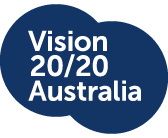MEDIA RELEASE
Victoria’s Vietnamese community are encouraged to get their eyes tested in the lead up to Lunar New Year.
Vietnamese is the fifth most spoken language in homes across Victoria. In some local government areas, such as Brimbank and Greater Dandenong, it is the most common foreign language spoken at home accounting for 14.23%¹ and 10.96%¹ of each area’s population respectively.
Vision 2020 Australia’s Vision Initiative Manager Dee Tumino said one in four Victorian adults who spoke a language other than English at home had never had an eye test ².
“These statistics are concerning and put a large number of Victorians at increased risk of vision loss,” Ms Tumino said.
Ms Tumino said that non-English speaking residents had greater issues around accessing services due to language and cultural barriers and therefore are often under-represented in screening.
“Often language prohibits people from non-English speaking backgrounds from accessing information and services which are readily available for English-speaking Australians,” she said.
A 2016 survey conducted by the Vision Initiative in the Vietnamese community of Brimbank and Greater Dandenong identified low rates of eye tests among the Vietnamese community.
In addition, awareness of the best ways to look after your eyes appeared to be limited with less than half of respondents recognising smoking, diabetes, sun exposure and lack of wearing eye protection as potential risk factors to sight loss despite being some of the most common risk factors.
The good news is that in Australia, 90% of vision loss is preventable or treatable if detected early³.
Regular eye tests can help detect problems with vision before symptoms are noticed. Early detection and treatment can reduce and even prevent vision loss from conditions like age-related macular degeneration, cataracts, diabetic retinopathy, glaucoma and refractive error.
Vietnamese speaking optometrist Vianh Huynh encourages all Vietnamese Victorians to get their eyes tested.
“Many eye diseases have no symptoms in the early stage. It’s crucial to have an eye test before you notice a change in your vision,” said Ms Huynh.
“If you are over the age of 40, have a family history of eye disease, smoke or have been diagnosed with diabetes, an eye test at least every two to three years is essential to identify problems early. A simple eye test can prevent vision loss and save sight.”
In addition to regular eye tests, there are many other good habits that can be adopted to protect your sight. These include:
- Wearing a hat and sunglasses when outside
- Wearing eye protection when playing sports such as squash, doing the gardening or working in a dangerous environment
- Maintaining a healthy diet and exercise
- Keeping good control of your diabetes
- Not smoking or quitting
- Following advice if you are under the care of an eye health professional.
The Vision Initiative team will be distributing free information on eye health and answering questions at the Tet Lunar Festival at the Flemington Showgrounds on Saturday 4 and Sunday 5 February 2017.
ENDS
For more information: Jenelle Whittaker at Vision 2020 Australia
03 9656 2020 or jwhittaker@vision2020australia.org.au
About the Vision Initiative
Managed by Vision 2020 Australia, the Vision Initiative is the Victorian Government’s public health response to the National Framework for Action to Promote Eye Health and Prevent Avoidable Blindness and Vision Loss. Commencing in 2002, the aim of the Vision Initiative is to prevent avoidable blindness and address the impact of vision impairment in the Victorian community. For more information visit: www.visioninitiative.org.au
About Vision 2020 Australia
Established in October 2000, Vision 2020 Australia is part of VISION 2020: The Right to Sight, a global initiative of the World Health Organisation (WHO) and the International Agency for the Prevention of Blindness (IAPB). As the national peak body for the eye health and vision care sector, Vision 2020 Australia represents over 50 member organisations involved in: local and global eye care; health promotion; low vision support; vision rehabilitation; eye research; professional assistance; and community support. For more information visit: www.vision2020australia.org.au
¹ Australia Bureau of Statistics 2011
² Victorian Department of Health, 2014, 2011-12 Victorian Population Health Survey (unpublished data), Victorian State Government, Melbourne
³ Foreman, J., et al, 2016, The National Eye Health Survey Report 2016, The Centre for Eye Research Australia and Vision 2020 Australia, Melbourne
